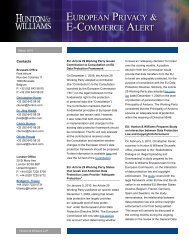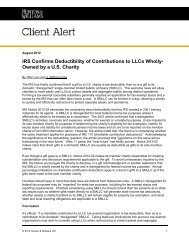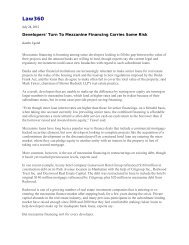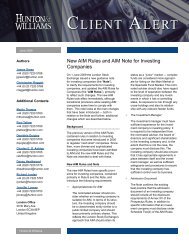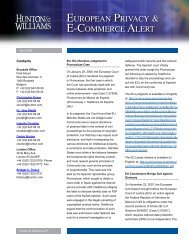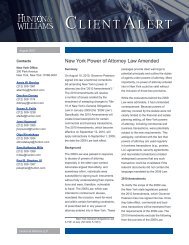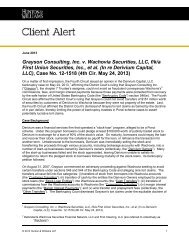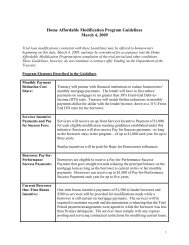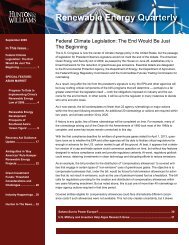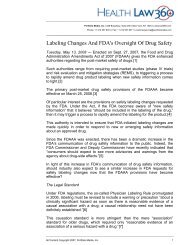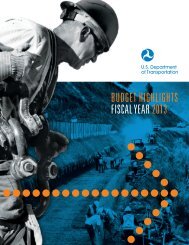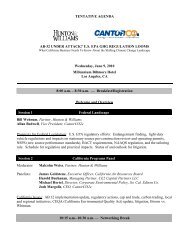"Doing Deals Under the SEC's Revised Cross-Border Tender Offer ...
"Doing Deals Under the SEC's Revised Cross-Border Tender Offer ...
"Doing Deals Under the SEC's Revised Cross-Border Tender Offer ...
Create successful ePaper yourself
Turn your PDF publications into a flip-book with our unique Google optimized e-Paper software.
Securities Regulation<br />
Law Journal<br />
Volume 37 Number 3 Fall 2009<br />
Corporate Governance and Shareholder<br />
Democracy — Change on <strong>the</strong> Horizon<br />
Hall Street Blues: The Uncertain Future<br />
of Manifest Disregard<br />
<strong>Doing</strong> <strong>Deals</strong> <strong>Under</strong> <strong>the</strong> <strong>SEC's</strong> <strong>Revised</strong><br />
<strong>Cross</strong>-<strong>Border</strong> <strong>Tender</strong> <strong>Offer</strong>, Exchange<br />
<strong>Offer</strong> and Business Combination Rules<br />
By Joris M. Hogan<br />
By Jill Gross<br />
By Scott D. McKinney<br />
The Pitfalls of Waiver in Corporate<br />
Prosecutions: Sharing Work Product<br />
with <strong>the</strong> Government and <strong>the</strong> Uncertain<br />
Future of Non-Waiver Agreements<br />
By Mat<strong>the</strong>w L. Mustokoff<br />
FINRA 2008: An Oscar Winning Year?<br />
By Deborah G. Heilizer,<br />
Brian L. Rubin and<br />
Shanyn L. Gillespie<br />
FINRA Reminds Securities Broker-Dealers of<br />
Their Duty of Due Diligence to Prevent<br />
<strong>the</strong> Public Resale of “Unregistered Securities”<br />
By Robert A. Barron<br />
Quarterly Survey of SEC Rulemaking<br />
and Major Appellate Decisions<br />
By Victor M. Rosenzweig
Editor-in-chief:<br />
Attorney Editor:<br />
Publishing Specialist:<br />
Publisher:<br />
Marc i. Steinberg<br />
Radford Professor of Law SMU School of Law<br />
Tyesha Witcher<br />
Kristin A. Fisher<br />
Jean E. Maess<br />
BOARD OF CONTRIBUTING EDITORS AND ADVISORS<br />
ROBERT A. BARRON<br />
BARBARA BLACK<br />
DENNIS J. BLOCK<br />
ALAN R. BROMBERG<br />
GERALD S. BACKMAN<br />
ARTHUR FLEISCHER, JR.<br />
EDWARD D. HERLIHY<br />
BRUCE HILER<br />
J ORIS M. HOGAN<br />
RALPH S. JANVEY<br />
ROBERTA S. KARMEL<br />
PROF. MICHAEL J. KAUFMAN<br />
BRUCE MENDELSOHN<br />
Marvin G. Pickholz<br />
HARVEY L. PITT<br />
JONATHAN D. POLKES, ESQ.<br />
DAVID L. RATNER<br />
FRANK C. RAZZANO<br />
VICTOR M. ROSENZWEIG<br />
MARK A. SARGENT<br />
CARL W. SCHNEIDER<br />
Smith Barney, Inc., Ret.<br />
University of Cincinnati College of Law<br />
Caldwater, Wickersham & Taft<br />
SMU School of Law and of Counsel, Jenkins & Gilchrist<br />
Weil, Gotshal & Manges LLP<br />
Fried, Frank, Harris, Shriver & Jacobson<br />
Watchell, Lipton, Rosen & Katz<br />
Cadwalader Wickersham<br />
Torys LLP<br />
Krage & Janvey<br />
Brooklyn School of Law<br />
Associate Dean, Loyola University School of Law<br />
Akin, Gump, Strauss, Hauer & Feld<br />
Pickholz Law Firm LLP<br />
Former Chairman, Securities and Exchange Commission<br />
Weil, Gotshal & Manges LLP<br />
University of San Francisco School of Law<br />
Pepper Hamilton LLP<br />
Olshan Grundman Frome Rosenzweig & Wolosky LLP<br />
Villanova University School of Law<br />
Wolf, Block, Schorr & Solis-Cohen
<strong>Doing</strong> <strong>Deals</strong> <strong>Under</strong> <strong>the</strong> <strong>SEC's</strong> <strong>Revised</strong><br />
<strong>Cross</strong>-<strong>Border</strong> <strong>Tender</strong> Oer, Exchange<br />
Oer and Business Combination Rules<br />
By Scott D. McKinney*<br />
The SEC revised its cross-border transaction rules in late 2008 to<br />
reduce regulatory conict between U.S. and foreign rules and market<br />
practices, with <strong>the</strong> goal of facilitating <strong>the</strong> inclusion of U.S. investors in<br />
cross-border transactions who might o<strong>the</strong>rwise be excluded by bidders<br />
due to such regulatory conict. The revised rules provide bidders<br />
greater certainty and exibility in structuring deals for non-U.S.<br />
targets. This article provides an overview of <strong>the</strong> <strong>SEC's</strong> revisions to its<br />
cross-border transaction rules and related interpretive guidance.<br />
The Securities and Exchange Commission (“SEC”) adopted amendments<br />
in 2008 to its rules for cross-border tender oers, exchange offers<br />
and business combinations. 1 These cross-border rules apply when<br />
<strong>the</strong> target company in a tender oer, exchange oer or business<br />
combination is a “foreign private issuer,” as dened in Rule 3b-4(c)<br />
under <strong>the</strong> Securities Exchange Act of 1934, as amended (<strong>the</strong><br />
“Exchange Act”). In <strong>the</strong> <strong>SEC's</strong> Adopting Release describing <strong>the</strong> amendments,<br />
<strong>the</strong> SEC also provides interpretive guidance with respect to<br />
certain of <strong>the</strong>se rules. The amendments were adopted substantially as<br />
proposed 2 and represent <strong>the</strong> rst major changes to <strong>the</strong> cross-border<br />
business combination transaction 3 rules since <strong>the</strong>y were adopted in<br />
1999. 4 The amendments have been eective since December 8, 2008.<br />
The amendments address areas of continuing conict or inconsistency<br />
between U.S. rules and foreign regulations and practice in <strong>the</strong><br />
cross-border area, but do not alter <strong>the</strong> nature or scope of <strong>the</strong> 1999<br />
cross-border regulatory framework. Many of <strong>the</strong> rule changes <strong>the</strong> SEC<br />
adopted codify sta interpretive and no-action positions and exemptive<br />
orders. The amendments are intended to encourage more oerors<br />
and issuers in cross-border business combination transactions to<br />
permit U.S. security holders to participate in <strong>the</strong>se transactions in <strong>the</strong><br />
same manner as o<strong>the</strong>r holders. Time will tell whe<strong>the</strong>r <strong>the</strong> revisions<br />
will achieve this goal. In two instances, <strong>the</strong> SEC extends rule changes<br />
to apply to all tender oers, including those for U.S. target companies. 5<br />
* Scott D. McKinney is a counsel in <strong>the</strong> Washington, D.C. oce of Hunton & Williams<br />
LLP. He can be reached at smckinney@hunton.com.<br />
248
[Vol. 37:3 2009] <strong>Doing</strong> <strong>Deals</strong> <strong>Under</strong> <strong>Revised</strong> SEC <strong>Cross</strong>-<strong>Border</strong> Rules<br />
The Adopting Release also includes revisions to <strong>the</strong> benecial ownership<br />
reporting rules for certain foreign institutions.<br />
I. Background<br />
Before <strong>the</strong> original cross-border exemptions were adopted in 1999,<br />
U.S. investors were routinely excluded from cross-border transactions<br />
because acquirors were concerned about U.S. regulatory burdens associated<br />
with extending oers to U.S. investors and conicts with<br />
foreign local laws. The SEC attempted to remedy <strong>the</strong>se concerns with<br />
<strong>the</strong> adoption of <strong>the</strong> cross-border rules, which provide two tiers of<br />
exemptive relief from <strong>the</strong> <strong>SEC's</strong> generally applicable tender oer and<br />
registration requirements based on <strong>the</strong> percentage of target securities<br />
of a non-U.S. issuer benecially owned by U.S. holders. For purposes<br />
of <strong>the</strong> cross-border rules, a U.S. holder is any security holder resident<br />
in <strong>the</strong> United States.<br />
Tier I. Where no more than 10% of <strong>the</strong> subject securities are held<br />
in <strong>the</strong> U.S., a qualifying cross-border transaction will be exempt from<br />
most U.S. tender oer rules pursuant to Tier I 6 exemptive relief and,<br />
where <strong>the</strong> transaction consideration includes acquirer securities, from<br />
<strong>the</strong> registration requirements of Section 5 of <strong>the</strong> Securities Act of<br />
1933, as amended (<strong>the</strong> “Securities Act”), pursuant to Securities Act<br />
Rules 801 and 802. Tier I transactions are also exempt from <strong>the</strong> additional<br />
disclosure requirements for going private transactions under<br />
SEC rules. 7 U.S. target security holders must be permitted to participate<br />
in <strong>the</strong> qualifying cross-border transaction oer on terms at least<br />
as favorable as those aorded o<strong>the</strong>r target holders. Also, U.S. target<br />
security holders must be provided with <strong>the</strong> oering materials, in English,<br />
on a comparable basis to that provided to o<strong>the</strong>r target holders.<br />
Tier II. Relief under Tier II applies when more than 10% but no<br />
more than 40% of <strong>the</strong> subject securities are held in <strong>the</strong> U.S. 8 The Tier<br />
II exemptions encompass narrowly-tailored relief to address recurring<br />
areas of regulatory conict with respect to tender oers, such as <strong>the</strong><br />
prompt payment, tender oer extension and notice of extension<br />
requirements in Regulation 14E. The Tier II exemptions do not<br />
provide relief from <strong>the</strong> registration requirements of Securities Act<br />
Section 5, nor do <strong>the</strong>y include an exemption from <strong>the</strong> additional<br />
disclosure requirements of Rule 13e-3 applicable to going private<br />
transactions.<br />
<strong>Cross</strong>-border business combination transactions eligible for Tier I or<br />
II exemptive relief remain subject to <strong>the</strong> antifraud and antimanipulation<br />
provisions of <strong>the</strong> U.S. securities laws. Where <strong>the</strong> level of<br />
U.S. benecial ownership in <strong>the</strong> non-U.S. subject company exceeds 40<br />
percent, cross-border business combinations must fully comply with<br />
<strong>the</strong> <strong>SEC's</strong> applicable tender oer and registration rules, to <strong>the</strong> extent<br />
specic no-action relief is not obtained.<br />
249
Securities Regulation Law Journal<br />
Even when Tier I or II exemptive relief was available under <strong>the</strong><br />
original cross-border rules, many bidders continued to exclude U.S.<br />
shareholders from oers due to ambiguity in applying <strong>the</strong> cross-border<br />
rules, continuing challenges in reconciling U.S. and foreign requirements,<br />
and concern over exposure to liability and litigation in <strong>the</strong><br />
U.S. The amendments to <strong>the</strong> cross-border exemptions address certain<br />
of <strong>the</strong>se impediments to bidders taking advantage of <strong>the</strong> cross-border<br />
exemptions.<br />
II. Summary of Revisions to <strong>Cross</strong>-<strong>Border</strong> Rules<br />
The <strong>SEC's</strong> revisions are intended to address <strong>the</strong> most frequent areas<br />
of conict or inconsistency with foreign regulations and practice<br />
that acquirors encounter in cross-border business combination<br />
transactions. The SEC acknowledges that <strong>the</strong>se revisions will not<br />
eliminate all conicts in law or practice presented by cross-border<br />
business combination transactions. The SEC sta will continue to address<br />
those conicts in law or practice in cross-border business<br />
combination transactions not covered by <strong>the</strong>se revisions on a case-bycase<br />
basis, as is currently <strong>the</strong> practice.<br />
(a) <strong>Revised</strong> Eligibility Test for <strong>the</strong> <strong>Cross</strong>-<strong>Border</strong> Exemptions<br />
The revised rules do not change <strong>the</strong> threshold percentages of U.S.<br />
ownership for reliance on <strong>the</strong> cross-border exemptions; however, <strong>the</strong><br />
SEC changed <strong>the</strong> manner in which <strong>the</strong>se percentages are determined.<br />
In particular, as discussed below, <strong>the</strong> revised rules include changes to<br />
<strong>the</strong> manner in which <strong>the</strong> look-through analysis for negotiated transactions<br />
9 must be conducted, to alleviate timing concerns associated with<br />
that calculation. To address situations were acquirors in negotiated<br />
transactions are unable to conduct this analysis, <strong>the</strong> SEC adopted an<br />
alternate test for determining eligibility to rely on <strong>the</strong> cross-border<br />
exemptions, based in part on a comparison of average daily trading<br />
volume (“ADTV”) of <strong>the</strong> subject securities in <strong>the</strong> U.S. and worldwide.<br />
This alternate test, discussed below, is also available for all nonnegotiated<br />
transactions (not conducted pursuant to an agreement between<br />
<strong>the</strong> target and <strong>the</strong> acquiror) and replaces <strong>the</strong> hostile presumption<br />
10 test.<br />
(i) Changes to Look-Through Analysis<br />
To measure <strong>the</strong> level of U.S. ownership of securities for <strong>the</strong> purpose<br />
of determining eligibility to rely on <strong>the</strong> cross-border exemptions, an<br />
acquiror in a negotiated transaction 11 must “look through” <strong>the</strong> record<br />
ownership of brokers, dealers, banks and o<strong>the</strong>r nominees resident in<br />
specied jurisdictions—which are <strong>the</strong> U.S., <strong>the</strong> issuer's home jurisdiction<br />
and, if dierent, <strong>the</strong> jurisdiction of primary trading market—to<br />
identify securities benecially held by persons located in <strong>the</strong> U.S. 12<br />
250
[Vol. 37:3 2009] <strong>Doing</strong> <strong>Deals</strong> <strong>Under</strong> <strong>Revised</strong> SEC <strong>Cross</strong>-<strong>Border</strong> Rules<br />
(1) Change to Reference Date and Expansion of Time Frame<br />
for Determining Eligibility. <strong>Under</strong> <strong>the</strong> rules before <strong>the</strong> amendments,<br />
acquirors were required to calculate U.S. ownership as of a set<br />
date — <strong>the</strong> 30 th day before <strong>the</strong> commencement of a tender oer or<br />
before <strong>the</strong> solicitation for a business combination o<strong>the</strong>r than a tender<br />
oer. The revisions (i) change <strong>the</strong> reference date to <strong>the</strong> public announcement<br />
of a business combination transaction and (ii) expand <strong>the</strong><br />
time frame for determining eligibility. For <strong>the</strong>se purposes, <strong>the</strong> SEC<br />
considers “public announcement” to be any oral or written communication<br />
by <strong>the</strong> acquiror or any party acting on its behalf, which is reasonably<br />
designed to inform, or has <strong>the</strong> eect of informing, <strong>the</strong> public or<br />
security holders in general about <strong>the</strong> transaction. 13 <strong>Under</strong> <strong>the</strong> <strong>SEC's</strong><br />
revised rules, an acquiror seeking to rely on <strong>the</strong> cross-border exemptions<br />
may calculate U.S. ownership as of any date no more than 60<br />
days before and no more than 30 days after <strong>the</strong> public announcement<br />
of <strong>the</strong> cross-border transaction. 14 Where <strong>the</strong> issuer or acquiror is unable<br />
to complete <strong>the</strong> look-through analysis within this 90-day period,<br />
it may use a date within 120 days before public announcement. 15<br />
Where <strong>the</strong> acquiror or issuer cannot accomplish <strong>the</strong> look-through<br />
analysis within this time period, it may use <strong>the</strong> alternate test<br />
described below.<br />
Using public announcement instead of commencement as <strong>the</strong> reference<br />
point for <strong>the</strong> calculation will allow acquirors to determine and<br />
inform <strong>the</strong> market and target holders about <strong>the</strong> treatment of U.S.<br />
holders at an earlier stage in <strong>the</strong> process. In addition, this change allows<br />
<strong>the</strong> calculation of U.S. ownership to be made before <strong>the</strong> target<br />
security holder base is aected by <strong>the</strong> public announcement. The SEC<br />
expanded <strong>the</strong> rule to permit <strong>the</strong> calculation as of a date no more than<br />
30 days after announcement to address concerns about <strong>the</strong> condentiality<br />
of <strong>the</strong> look-through analysis. Where that analysis must be<br />
conducted before announcement, it may compromise <strong>the</strong> condentiality<br />
of <strong>the</strong> transaction. 16<br />
(2) 10% or More Holders No Longer Excluded. <strong>Under</strong> <strong>the</strong> <strong>SEC's</strong><br />
revised rules, individual holders of more than 10 percent of <strong>the</strong> subject<br />
securities are no longer required to be excluded from <strong>the</strong> calculation<br />
of U.S. ownership, as <strong>the</strong>y were under <strong>the</strong> rules before <strong>the</strong><br />
amendments. This change should increase <strong>the</strong> availability of <strong>the</strong> crossborder<br />
exemption. Requiring <strong>the</strong> exclusion of large target holders generally<br />
has <strong>the</strong> eect of skewing upward <strong>the</strong> percentage of U.S. ownership<br />
of foreign private issuers, which in turn decreases <strong>the</strong> availability<br />
of <strong>the</strong> cross-border exemptions. The SEC, however, is retaining <strong>the</strong><br />
requirement that securities held by <strong>the</strong> acquiror must be excluded<br />
from both <strong>the</strong> numerator and denominator in calculating U.S. benecial<br />
ownership.<br />
251
Securities Regulation Law Journal<br />
(ii) Alternate Test for Determining Percentage of U.S.<br />
Holders<br />
Where an issuer or acquiror in a negotiated transaction is unable to<br />
conduct <strong>the</strong> look-through analysis mandated in <strong>the</strong> SEC rules, it may<br />
use an alternate test, based in part on a comparison of ADTV in <strong>the</strong><br />
U.S. and worldwide. Acquirors in all non-negotiated transactions may<br />
also rely on <strong>the</strong> alternate test, which is similar to and replaces <strong>the</strong><br />
hostile presumption test.<br />
(1) Circumstances Justifying Use of <strong>the</strong> Alternate Test<br />
The Adopting Release states that merely needing to dedicate<br />
substantial time and resources to <strong>the</strong> “look-through” analysis or having<br />
concerns about <strong>the</strong> completeness and accuracy of <strong>the</strong> U.S. ownership<br />
levels obtained by completing a “look-through” analysis will not<br />
necessarily justify use of <strong>the</strong> alternate test. Fur<strong>the</strong>rmore, <strong>the</strong> Adopting<br />
Release makes clear that acquirors must make a good faith eort<br />
to conduct a reasonable inquiry into determining <strong>the</strong> level of U.S. benecial<br />
ownership. The SEC did not provide an exhaustive list of <strong>the</strong><br />
situations that would justify <strong>the</strong> use of <strong>the</strong> alternate test, but noted a<br />
few examples where <strong>the</strong> alternate test would be appropriate, such as:<br />
where security holder lists are generated only at xed intervals and<br />
<strong>the</strong> published information is as of a date outside <strong>the</strong> range specied<br />
for calculation; where nominees are prohibited by law from disclosing<br />
information about <strong>the</strong> benecial owners on whose behalf <strong>the</strong>y hold; or<br />
where <strong>the</strong> subject securities are in bearer form.<br />
<strong>Under</strong> <strong>the</strong> alternate test, an acquiror may rely on <strong>the</strong> cross-border<br />
exemptions unless, as discussed below: (i) ADTV in <strong>the</strong> U.S. exceeds<br />
<strong>the</strong> threshold percentages set forth in <strong>the</strong> <strong>SEC's</strong> rules, (ii) reports led<br />
by <strong>the</strong> target company indicate levels of U.S. ownership inconsistent<br />
with <strong>the</strong> limits for <strong>the</strong> applicable exemption, or (iii) <strong>the</strong> acquiror knows<br />
or has reason to know that U.S. ownership exceeds <strong>the</strong> limits for <strong>the</strong><br />
applicable exemption.<br />
(2) Elements of <strong>the</strong> Alternate Test<br />
The rst prong of <strong>the</strong> alternative test is satised where ADTV for<br />
<strong>the</strong> subject securities in <strong>the</strong> U.S. over a twelve-month period ending<br />
no more than 60 days before <strong>the</strong> announcement of <strong>the</strong> transaction is<br />
not more than 10 percent (40 percent for Tier II) of <strong>the</strong> ADTV on a<br />
worldwide basis. 17 Similar to <strong>the</strong> revised look-through analysis, <strong>the</strong><br />
alternate test provides acquirors with a range of dates by which <strong>the</strong>y<br />
may make <strong>the</strong> comparison of U.S. and worldwide ADTV; that range<br />
does not, however, extend beyond <strong>the</strong> date of announcement. The<br />
revised rules require that <strong>the</strong>re be a “primary trading market” for <strong>the</strong><br />
subject securities, as <strong>the</strong> term is dened in <strong>the</strong> <strong>SEC's</strong> rules, in order<br />
for <strong>the</strong> acquiror in a negotiated transaction to rely on <strong>the</strong> alternate<br />
252
[Vol. 37:3 2009] <strong>Doing</strong> <strong>Deals</strong> <strong>Under</strong> <strong>Revised</strong> SEC <strong>Cross</strong>-<strong>Border</strong> Rules<br />
test as a result of being unable to conduct <strong>the</strong> look-through analysis.<br />
“Primary trading market” means that at least 55% of <strong>the</strong> trading volume<br />
in <strong>the</strong> subject securities takes place in a single, or no more than<br />
two, foreign jurisdictions during a recent 12-month period. 18 In addition,<br />
if <strong>the</strong> trading of <strong>the</strong> subject securities occurs in two foreign<br />
markets, <strong>the</strong> trading in at least one of <strong>the</strong> two must be larger than<br />
<strong>the</strong> trading in <strong>the</strong> U.S. for that class.<br />
The second prong of <strong>the</strong> alternate test is that <strong>the</strong> acquiror must<br />
consider information about U.S. ownership levels that appear in annual<br />
reports or o<strong>the</strong>r annual information led by <strong>the</strong> issuer with <strong>the</strong><br />
SEC or with <strong>the</strong> regulator in its home jurisdiction before <strong>the</strong> public<br />
announcement of <strong>the</strong> transaction. It may be disqualied from relying<br />
on <strong>the</strong> cross-border exemption sought if those reports or o<strong>the</strong>r lings<br />
indicate levels of U.S. ownership that exceed applicable limits for that<br />
exemption. 19 The only change from <strong>the</strong> pre-amendment comparable element<br />
for non-negotiated transactions is <strong>the</strong> limitation on <strong>the</strong> type of<br />
lings that must be considered under <strong>the</strong> revised rules (i.e., annual<br />
reports and o<strong>the</strong>r annual information) and <strong>the</strong> time limit on <strong>the</strong> information<br />
<strong>the</strong> acquiror must considered under <strong>the</strong> revised rules (i.e., information<br />
led before public announcement).<br />
Finally, <strong>the</strong> revised rules retain <strong>the</strong> condition that <strong>the</strong> acquirer<br />
must not have a “reason to know” that <strong>the</strong> target's U.S. benecial<br />
ownership levels exceed applicable limits for a particular exemption.<br />
The revised rules clarify that an oeror has reason to know any information<br />
(whe<strong>the</strong>r made available by <strong>the</strong> issuer or any third party) that<br />
is publicly available, including benecial ownership information led<br />
with <strong>the</strong> SEC, a home country regulator or (if dierent) <strong>the</strong> jurisdiction<br />
in which its primary trading market is located. 20 An oeror must<br />
also take into account information available from <strong>the</strong> issuer or<br />
obtained or readily available from any o<strong>the</strong>r source that is reasonably<br />
reliable, 21 including <strong>the</strong> parties' advisors to <strong>the</strong> transaction and independent<br />
information service providers. However, an acquiror seeking<br />
to rely on <strong>the</strong> presumption is not required to engage such third parties<br />
for such purpose. The relevant cut-o date for <strong>the</strong> bidder's actual<br />
or imputed knowledge is <strong>the</strong> date of announcement, permitting a bidder<br />
to disregard conicting information received after such date.<br />
(b) Changes to Eligibility Test for Rights Oerings<br />
The SEC adopted changes similar to those for business combinations<br />
to <strong>the</strong> method of calculating U.S. ownership for purposes of <strong>the</strong><br />
exemption for rights oerings. Issuers may now calculate U.S. ownership<br />
as of a date no more than 60 days before and 30 days after <strong>the</strong><br />
record date for <strong>the</strong> rights oering. 22 Thus, issuers will have greater<br />
exibility on <strong>the</strong> timing of <strong>the</strong> calculation of U.S. ownership within a<br />
range of dates; however, <strong>the</strong> reference point for <strong>the</strong> calculation will<br />
253
Securities Regulation Law Journal<br />
continue to be <strong>the</strong> record date for rights oerings, ra<strong>the</strong>r than <strong>the</strong><br />
date of public announcement for business combinations. In addition to<br />
<strong>the</strong> changes to <strong>the</strong> look-through analysis mandated under <strong>the</strong> SEC<br />
revised rules, <strong>the</strong> alternate test for calculating U.S. ownership also<br />
will be available for issuers unable to conduct <strong>the</strong> look-through<br />
analysis.<br />
(c) Revisions to Tier I Exemptions: Expanded Exemption<br />
from Rule 13e-3<br />
Exchange Act Rule 13e-3 requires certain heightened disclosure for<br />
“going private” transactions because of <strong>the</strong> conicts of interest inherent<br />
in such transactions. 23 In broad terms “going private” transactions<br />
are purchases of a company listed in <strong>the</strong> U.S. by <strong>the</strong> company itself or<br />
an aliate of that company that result in <strong>the</strong> company becoming<br />
deregistered or delisted. Prior to <strong>the</strong> amendments, <strong>the</strong> Tier I exemption<br />
provided relief from <strong>the</strong> enhanced disclosure requirements for<br />
only particular types of aliated transactions under Rule 13e-3,<br />
including tender oers. It did not apply to some transaction structures<br />
commonly used in non-U.S. jurisdictions, such as schemes of arrangements,<br />
cash mergers and compulsory acquisitions for cash. <strong>Revised</strong><br />
Rule 13-3(g) permits all transaction structures to be exempt from <strong>the</strong><br />
Rule 13e-3 disclosure requirements if <strong>the</strong>y meet <strong>the</strong> conditions set<br />
forth in Rule 802 or <strong>the</strong> Tier I exemption.<br />
(d) Revisions to Tier II Exemptions<br />
The exemptive relief available for Tier II-eligible transactions is<br />
designed principally to allow bidders in cross-border tender oers to<br />
comply with certain home country procedural practices and requirements<br />
that dier from U.S. rules. The revised rules for Tier II transactions<br />
mainly address practical issues that have often been <strong>the</strong> subject<br />
of requests for exemptive or no-action letter relief.<br />
(i) Tier II Relief for Regulation 14E-Only Transactions 24<br />
The SEC sta had previously informally taken <strong>the</strong> position that <strong>the</strong><br />
Tier II exemptions should be available for tender oers that o<strong>the</strong>rwise<br />
would qualify for <strong>the</strong> exemptions, but for <strong>the</strong> fact that <strong>the</strong> transaction<br />
is not subject to Rule 13e-4 or Regulation 14D (such as tender oers<br />
for securities that are not registered under Section 12 of <strong>the</strong> Exchange<br />
Act). The SEC has codied this position in <strong>the</strong> revised Tier II rules,<br />
which specically make <strong>the</strong> Tier II exemptions available to oers<br />
subject to only Regulation 14E, 25 where <strong>the</strong> exemptions would have<br />
been available if those oers were subject to Rule 13e-4 or Regulation<br />
14D. 26<br />
Certain of <strong>the</strong> Tier II exemptions may not be necessary for tender<br />
oers not subject to <strong>the</strong> requirements of Rule 13e-4 or Regulation<br />
14D, because Regulation 14E may not have a corresponding regula-<br />
254
[Vol. 37:3 2009] <strong>Doing</strong> <strong>Deals</strong> <strong>Under</strong> <strong>Revised</strong> SEC <strong>Cross</strong>-<strong>Border</strong> Rules<br />
tory requirement. For example, <strong>the</strong>re is no requirement in Regulation<br />
14E to make a tender oer available to all target security holders.<br />
Therefore, <strong>the</strong> accommodation from <strong>the</strong> all-holders provisions in<br />
Exchange Act Rules 13e-4(i)(2)(ii) and 14d-1(d)(2)(ii) will not be necessary<br />
for an oer subject only to Regulation 14E.<br />
(ii) Tier II Relief for Concurrent U.S. and Non-U.S. Oers<br />
Multiple non-U.S. oers in connection with a U.S. oer. The<br />
revised rules permit <strong>the</strong> use of more than one oer outside of <strong>the</strong> U.S.<br />
for tender oers conducted under Tier II. 27 Prior to <strong>the</strong> amendments,<br />
<strong>the</strong> Tier II cross-border exemptions permitted a bidder to conduct only<br />
two separate but concurrent tender oers: (i) one open only to U.S.<br />
target security holders and (ii) ano<strong>the</strong>r open only to non-U.S. target<br />
holders. However, in some instances, a tender oer may be subject to<br />
more than one regulatory regime outside <strong>the</strong> U.S., particularly where<br />
<strong>the</strong> target's country of incorporation is not <strong>the</strong> location of <strong>the</strong> primary<br />
trading market for <strong>the</strong> target securities. Prior to <strong>the</strong> cross-border<br />
amendments, bidders requested and were granted relief to conduct<br />
more than one non-U.S. oer outside of <strong>the</strong> U.S. pursuant to <strong>the</strong> Tier<br />
II exemptions. 28 With regard to proration of tendered securities, under<br />
<strong>the</strong> preexisting as well as <strong>the</strong> revised rules, bidders who conduct separate<br />
non-U.S. and U.S. oers to minimize <strong>the</strong> diculties of complying<br />
with two dierent regulatory regimes applicable to <strong>the</strong> oer must<br />
prorate tendered securities on an aggregate basis, where required<br />
under U.S. rules.<br />
Expansion of <strong>the</strong> categories of persons who may participate<br />
in <strong>the</strong> U.S. oer and <strong>the</strong> non-U.S. oer. With regard to <strong>the</strong> U.S. offer,<br />
<strong>the</strong> revised rules allow a bidder in a cross-border tender oer<br />
conducted under Tier II to make <strong>the</strong> U.S. oer available to all holders<br />
of American Depositary Receipts (“ADRs”), including non-U.S.<br />
holders. 29 This rule change is not intended to enable a bidder to make<br />
an oer open only to ADR holders, which would be prohibited where<br />
<strong>the</strong> target securities are registered under Section 12 of <strong>the</strong> Exchange<br />
Act and <strong>the</strong> all-holders provisions of U.S. tender oer rules apply.<br />
Prior to <strong>the</strong> amendments, <strong>the</strong> Tier II exemptions specied that a U.S.<br />
oer conducted in connection with a concurrent non-U.S. oer under<br />
Tier II may be open to U.S. persons only. This limitation creates a<br />
problem because bidders frequently seek to include all holders of<br />
ADRs, not only U.S. holders in <strong>the</strong> U.S. portion of a dual oer. The<br />
SEC sta often granted relief to permit a U.S. oer in a dual oer<br />
structure to include all holders of ADRs, including non-U.S. holders of<br />
ADRs.<br />
With regard to <strong>the</strong> non-U.S. oer, <strong>the</strong> revised rules allow a bidder<br />
in a cross-border tender oer conducted under Tier II to make <strong>the</strong><br />
non-U.S. oer open to U.S. target security holders in situations where:<br />
255
Securities Regulation Law Journal<br />
(i) <strong>the</strong> laws of <strong>the</strong> non-U.S. target company's home jurisdiction<br />
expressly prohibit <strong>the</strong> exclusion of any target security holders, including<br />
U.S. persons; and (ii) <strong>the</strong> oer materials distributed to U.S.<br />
persons fully and completely describe <strong>the</strong> risks to U.S. holders of<br />
participating in <strong>the</strong> non-U.S. oer. 30<br />
(iii) Termination of Withdrawal Rights While Counting<br />
<strong>Tender</strong>ed Securities<br />
The Exchange Act and related SEC rules require bidders to provide<br />
“back-end” withdrawal rights if tendered securities have not been accepted<br />
for payment within a certain date after <strong>the</strong> commencement of<br />
a tender oer. 31 In many non-U.S. jurisdictions <strong>the</strong> counting of<br />
tendered securities after <strong>the</strong> end of <strong>the</strong> initial oering period can take<br />
substantial time during which such back-end withdrawal rights create<br />
uncertainty in determining whe<strong>the</strong>r a minimum tender condition<br />
has been met. <strong>Under</strong> <strong>the</strong> cross-border rules before <strong>the</strong> amendments,<br />
back-end withdrawal rights are suspended between <strong>the</strong> end of an<br />
initial oering period and <strong>the</strong> commencement of a subsequent oering<br />
period. The revised rules expand this relief by permitting a bidder in<br />
a cross-border tender oer conducted under Tier II to suspend backend<br />
withdrawal rights after <strong>the</strong> expiration of an oer while tendered<br />
securities are being counted and until those securities are accepted<br />
for payment, even if no subsequent oering period is ultimately<br />
provided, so long as: (i) <strong>the</strong> bidder has provided an oer period (including<br />
withdrawal rights) of at least 20 U.S. business days; 32 (ii) at <strong>the</strong><br />
time withdrawal rights are suspended, all oer conditions o<strong>the</strong>r than<br />
<strong>the</strong> minimum acceptance condition have been satised or waived; 33<br />
and (iii) back-end withdrawal rights are suspended only until tendered<br />
securities are counted and are reinstated immediately after that process,<br />
to <strong>the</strong> extent <strong>the</strong>y are not terminated by <strong>the</strong> acceptance of <strong>the</strong><br />
tendered securities. 34 The revised rules also operate to suspend backend<br />
withdrawal rights that may exist after <strong>the</strong> expiration of a<br />
subsequent oering period, to <strong>the</strong> extent <strong>the</strong> bidder meets <strong>the</strong> conditions<br />
outlined in <strong>the</strong> rules.<br />
(iv) Subsequent Oering Period Changes<br />
U.S. rules on subsequent oering periods have been a frequent<br />
source of conict with foreign regulations in <strong>the</strong> context of crossborder<br />
tender oers. The revised rules are intended to eliminate<br />
certain conicts.<br />
Maximum time limit on subsequent oering period<br />
eliminated. SEC tender oer rules prior to <strong>the</strong> amendments imposed<br />
a maximum time limit of 20 U.S. business days on <strong>the</strong> length of a<br />
subsequent oering period. However, subsequent oering periods of<br />
signicantly longer duration are common under law or practice in<br />
256
[Vol. 37:3 2009] <strong>Doing</strong> <strong>Deals</strong> <strong>Under</strong> <strong>Revised</strong> SEC <strong>Cross</strong>-<strong>Border</strong> Rules<br />
many non-U.S. jurisdictions. The revised tender oer rules eliminate<br />
<strong>the</strong> maximum time limit on <strong>the</strong> length of a subsequent oering period<br />
for all tender oers, including those for U.S. target companies. 35<br />
Subsequent oering periods may still be no shorter than three business<br />
days, in accordance with U.S. rules.<br />
Prompt payment of securities tendered during <strong>the</strong> subsequent<br />
oering period. U.S. tender oer rules mandate that securities<br />
tendered during a subsequent oering period must be paid for as<br />
soon as <strong>the</strong>y are tendered, on a “rolling” basis, which in practice means<br />
every day. In a cross-border tender oer, non-U.S. rules or practice<br />
often dictate payment practices during <strong>the</strong> subsequent oering period<br />
that conict with U.S. rules. For example, non-U.S. rules or practice<br />
may require securities tendered during <strong>the</strong> subsequent oering period<br />
to be paid for within a certain number of days after <strong>the</strong> expiration of<br />
<strong>the</strong> subsequent oering period or may require “bundling” of securities<br />
and payment on specied periodic take-up dates. The revised rules allow<br />
a bidder in a cross-border tender oer conducted pursuant to <strong>the</strong><br />
Tier II exemptions to bundle and pay for securities tendered in <strong>the</strong><br />
subsequent oering period within 20 business days of <strong>the</strong> date of<br />
tender. 36 For this purpose, a business day is determined by reference<br />
to <strong>the</strong> relevant non-US jurisdiction. However, under <strong>the</strong> revised rules,<br />
if local law mandates and local practice permits payment on a more<br />
expedited basis, payment must be made more quickly than 20 business<br />
days from <strong>the</strong> date of tender to satisfy U.S. prompt payment<br />
requirements.<br />
Payment of interest on securities tendered during <strong>the</strong><br />
subsequent oering period. In some non-U.S. jurisdictions, bidders<br />
are legally obligated to pay interest on securities tendered during a<br />
subsequent oering period. These payments, however, conict with<br />
U.S. rules that mandate that consideration paid to any tendering security<br />
holder be <strong>the</strong> highest consideration paid to any o<strong>the</strong>r security<br />
holder and that security holders that tender during <strong>the</strong> subsequent offering<br />
receive <strong>the</strong> same form and amount of consideration as security<br />
holders tendering into <strong>the</strong> initial oering period. Because of this prohibition,<br />
bidders in cross-border transactions prior to <strong>the</strong> amendments<br />
have requested and received exemptive relief to address <strong>the</strong> direct<br />
conict of law presented. The revised rules permit bidders in Tier II<br />
cross-border tender oers to pay interest on securities tendered during<br />
a subsequent oering period, where required under non-U.S. law. 37<br />
The revised rules do not limit <strong>the</strong> amount of interest that may be paid<br />
on securities tendered during <strong>the</strong> subsequent oering period. The<br />
<strong>SEC's</strong> rule change does not permit <strong>the</strong> payment of interest on securities<br />
tendered during <strong>the</strong> initial oering period.<br />
Mix and match oers and <strong>the</strong> initial and subsequent oering<br />
257
Securities Regulation Law Journal<br />
periods. In a mix and match oer, bidders oer a set mix of cash and<br />
securities in exchange for each target security, but permit tendering<br />
holders to request a dierent proportion of cash or securities. These<br />
elections by tendering holders are satised to <strong>the</strong> extent that o<strong>the</strong>r<br />
tendering security holders make osetting elections for <strong>the</strong> opposite<br />
proportion of cash and securities, subject to a maximum amount of<br />
cash or securities that <strong>the</strong> bidder is willing to issue. To facilitate <strong>the</strong><br />
timely payment of consideration to tendering security holders, bidders<br />
typically provide for two separate pools of cash and securities to be<br />
used to accommodate target shareholders' mix and match elections,<br />
one for <strong>the</strong> initial oering period and ano<strong>the</strong>r for <strong>the</strong> subsequent offering<br />
period. Mix and match oers may violate U.S. rules that prohibit<br />
<strong>the</strong> payment of dierent consideration in <strong>the</strong> initial and<br />
subsequent oering periods, as well as U.S. rules that prohibit <strong>the</strong><br />
imposition of a ceiling on any form of alternate consideration oered<br />
during <strong>the</strong> subsequent oering period. The revised rules expressly<br />
permit <strong>the</strong> use of separate oset “pools” for securities tendered during<br />
<strong>the</strong> initial and subsequent oering periods for cross-border tender offers<br />
conducted under Tier II. 38 The revised rules also eliminate <strong>the</strong><br />
prohibition on a ceiling for <strong>the</strong> form of consideration in a mix and<br />
match cross-border oer under Tier II, where target security holders<br />
are able to elect to receive alternate forms of consideration in <strong>the</strong><br />
oer. 39<br />
(v) Reduction or Waiver of Minimum Acceptance Condition<br />
<strong>Under</strong> U.S. tender oer rules, a bidder must keep a tender oer<br />
open for a prescribed period after a material change in <strong>the</strong> terms of<br />
<strong>the</strong> oer and must provide withdrawal rights during such period.<br />
Generally, waiving or reducing <strong>the</strong> minimum acceptance condition is<br />
considered a material change in <strong>the</strong> terms of <strong>the</strong> oer. However, this<br />
conicts with law or practice in certain non-U.S. jurisdictions, including,<br />
in particular, <strong>the</strong> United Kingdom. Consequently, <strong>the</strong> SEC, when<br />
it initially adopted <strong>the</strong> <strong>Cross</strong>-<strong>Border</strong> Rules, armed <strong>the</strong> sta's<br />
interpretive guidance on when bidders meeting <strong>the</strong> conditions of <strong>the</strong><br />
Tier II exemption could, subject to a number of conditions, waive or<br />
reduce <strong>the</strong> minimum acceptance condition without providing withdrawal<br />
rights during <strong>the</strong> remainder of <strong>the</strong> oer.<br />
The SEC provided additional guidance in <strong>the</strong> Proposing Release<br />
that limits <strong>the</strong> scope of <strong>the</strong> relief, which guidance <strong>the</strong> SEC rearmed<br />
in <strong>the</strong> Adopting Release, with some fur<strong>the</strong>r modications. As reiterated<br />
in <strong>the</strong> Adopting Release, <strong>the</strong> SEC stated that its earlier guidance<br />
was intended to be relied upon only where law or practice in <strong>the</strong> applicable<br />
non-U.S. jurisdiction does not permit <strong>the</strong> bidder to provide<br />
withdrawal rights after <strong>the</strong> reduction or waiver. 40 The fact that a non-<br />
258
[Vol. 37:3 2009] <strong>Doing</strong> <strong>Deals</strong> <strong>Under</strong> <strong>Revised</strong> SEC <strong>Cross</strong>-<strong>Border</strong> Rules<br />
U.S. jurisdiction would merely allow such practice is not sucient. As<br />
a new requirement, <strong>the</strong> bidder may not waive or reduce <strong>the</strong> minimum<br />
acceptance condition below <strong>the</strong> percentage required for <strong>the</strong> bidder to<br />
control <strong>the</strong> target company after <strong>the</strong> tender oer under applicable<br />
non-U.S. law, and in any case, may not reduce or waive <strong>the</strong> minimum<br />
acceptance condition below a majority of <strong>the</strong> outstanding securities of<br />
<strong>the</strong> subject class. 41 The interpretive guidance does not apply to mandatory<br />
extensions of <strong>the</strong> initial oer period for changes related to <strong>the</strong> offer<br />
consideration, <strong>the</strong> amount of target securities sought in <strong>the</strong> oer<br />
or a change to <strong>the</strong> dealer's soliciting fee. 42 The SEC emphasized <strong>the</strong><br />
importance of including in <strong>the</strong> oer materials a robust discussion of<br />
<strong>the</strong> implications of any waiver or reduction, including at <strong>the</strong> specic<br />
levels contemplated.<br />
(vi) Early Termination of an Initial Oering Period or a<br />
Voluntary Extension of Such Period<br />
The SEC also considers a change in <strong>the</strong> expiration date of a tender<br />
oer as material, requiring a bidder to keep a tender oer open for a<br />
prescribed period after such change and to provide withdrawal rights<br />
during such period. This extension requirement in U.S. rules conicts<br />
with <strong>the</strong> law or practice in some non-U.S. jurisdictions, which mandate<br />
that once all oer conditions have been satised or waived, <strong>the</strong> initial<br />
oering period and withdrawal rights must terminate so that <strong>the</strong> bidder<br />
may begin <strong>the</strong> payment process. The <strong>SEC's</strong> sta has given noaction<br />
relief to terminate <strong>the</strong> initial oering period (or any voluntary<br />
extension <strong>the</strong>reof) before its scheduled expiration, <strong>the</strong>reby terminating<br />
withdrawal rights, upon satisfaction of all oer conditions. The<br />
revised rules codify this relief, permitting bidders in cross-border tender<br />
oers conducted under tier II to terminate an initial oering period,<br />
including a voluntary extension of that period, if at <strong>the</strong> time <strong>the</strong><br />
initial oering period and withdrawal rights end: (i) <strong>the</strong> initial oering<br />
period has been open for at least 20 U.S. business days; (ii) <strong>the</strong><br />
bidder has adequately discussed <strong>the</strong> possibility and <strong>the</strong> impact of <strong>the</strong><br />
early termination in <strong>the</strong> original oer materials; (iii) <strong>the</strong> bidder<br />
provides a subsequent oering period after <strong>the</strong> termination of <strong>the</strong><br />
initial oering period; (iv) all oer conditions are satised as of <strong>the</strong><br />
time when <strong>the</strong> initial oering period ends; and (v) <strong>the</strong> bidder does not<br />
terminate <strong>the</strong> initial oering period or any extension of that period<br />
during any mandatory extension required under U.S. tender oer<br />
rules. 43<br />
(vii) Exceptions From Rule 14e-5 for Tier II <strong>Cross</strong>-<strong>Border</strong><br />
<strong>Tender</strong> Oers<br />
Exchange Act Rule 14e-5 prohibits purchasing or arranging to<br />
purchase any subject securities or any related securities except as<br />
259
Securities Regulation Law Journal<br />
part of <strong>the</strong> tender oer. The rule's prohibitions apply from <strong>the</strong> time of<br />
public announcement of <strong>the</strong> tender oer until <strong>the</strong> oer expires. The<br />
rule applies to “covered persons,” which include, among o<strong>the</strong>rs, <strong>the</strong> offeror<br />
and its aliates and <strong>the</strong> oeror's dealer-manager and its<br />
aliates. The 1999 cross-border rules exempt Tier I tender oers from<br />
Rule 14e-5, 44 but not Tier II oers. The revised rules codify and rene<br />
three class exemptive letters in <strong>the</strong> Tier II cross-border tender oer<br />
context. 45<br />
Purchases pursuant to a foreign tender oer. New Exchange<br />
Act Rule 14e-5(b)(11) codies <strong>the</strong> ability of a bidder to purchase or arrange<br />
to purchase target securities of a non-U.S. issuer pursuant to a<br />
non-U.S. oer made concurrently or substantially concurrently with a<br />
U.S. Tier II tender oer. The exception is conditioned on U.S. security<br />
holders being treated at least as favorably, both economically and<br />
procedurally, as non-U.S. tendering security holders and <strong>the</strong> bidder<br />
disclosing in <strong>the</strong> U.S. oering documents its intention to make<br />
purchases pursuant to <strong>the</strong> non-U.S. tender oer. The exception is<br />
limited to purchases in non-U.S. tender oers and does not apply to<br />
open market transactions, private transactions, or o<strong>the</strong>r transactions<br />
outside <strong>the</strong> tender oer, although o<strong>the</strong>r exemptions may be available<br />
for such purchases.<br />
Purchases by an aliate of <strong>the</strong> nancial advisor and an offeror<br />
and its aliates. New Exchange Act Rule 14e-5(b)(12) codies<br />
<strong>the</strong> ability of bidders, <strong>the</strong>ir aliates and aliates of nancial advisors<br />
to purchase or arrange to purchase target securities of a non-U.S. issuer<br />
outside a Tier II tender oer; provided, that such purchases (i)<br />
are made outside <strong>the</strong> U.S.; (ii) are disclosed in <strong>the</strong> U.S., to <strong>the</strong> extent<br />
that such information is made public in <strong>the</strong> subject company's home<br />
jurisdiction; (iii) with regard to an aliate of a nancial advisor, are<br />
consistent with such aliate's normal and usual business practices<br />
and are not made to facilitate <strong>the</strong> tender oer, and <strong>the</strong> aliate is<br />
registered as a broker or dealer under Section 15(a) of <strong>the</strong> Exchange<br />
Act; and (iv) with regard to an oeror and its aliates, are at a price<br />
not exceeding <strong>the</strong> tender oer price. If purchases by <strong>the</strong> bidder or its<br />
aliates outside at tender oer are at price exceeding <strong>the</strong> tender oer<br />
price, <strong>the</strong>n <strong>the</strong> tender oer price must be increased to match such<br />
higher price. Additionally, <strong>the</strong> U.S. oering materials must disclose<br />
prominently <strong>the</strong> possibility of purchases of target securities outside of<br />
<strong>the</strong> tender oer.<br />
(e) Expanded Availability of Early Commencement<br />
<strong>Under</strong> <strong>the</strong> cross-border rules prior to <strong>the</strong> amendments, a bidder<br />
could commence an exchange oer before a related registration statement<br />
is declared eective (i.e., early commence) only when an<br />
exchange oer is subject to Rule 13e-4 or Regulation 14D. Such cross-<br />
260
[Vol. 37:3 2009] <strong>Doing</strong> <strong>Deals</strong> <strong>Under</strong> <strong>Revised</strong> SEC <strong>Cross</strong>-<strong>Border</strong> Rules<br />
border rules made no provision for early commencement of Regulation<br />
14E-only exchange oers, which include, for example, oers for<br />
unregistered equity securities and cross-border debt tender oers. In<br />
order to put such exchange oers on equal footing with cash tender offers<br />
and exchange oers subject to Rule 13e-4 or Regulation 14D, <strong>the</strong><br />
SEC amended its rules to allow “Regulation 14E-only” exchange offers—for<br />
both U.S. and foreign target companies—to commence upon<br />
<strong>the</strong> ling of <strong>the</strong> registration statement registering <strong>the</strong> oer, so long<br />
as: (i) <strong>the</strong> bidder provides withdrawal rights to <strong>the</strong> same extent as<br />
would be required under Rule 13e-4 and Regulation 14D; and (ii) if<br />
<strong>the</strong>re is a material change in <strong>the</strong> information provided to target security<br />
holders, <strong>the</strong> bidder must disseminate revised materials as would<br />
be required under Exchange Act Rules 13e-4(e)(3) and 14d-4(d) and<br />
must hold <strong>the</strong> oer open with withdrawal rights for <strong>the</strong> minimum<br />
time periods specied in those rules. 46 As is currently <strong>the</strong> case with<br />
exchange oers subject to Rules 13e-4 and Regulation 14D, no securities<br />
may be purchased until <strong>the</strong> registration statement is declared<br />
eective. The revised rules also make it clear that <strong>the</strong> prospectus<br />
delivery requirements of <strong>the</strong> Securities Act extend to Regulation 14Eonly<br />
oers. Early commencement is not available for roll-ups and<br />
going-private transactions.<br />
Since Regulation 14E-only exchange oers require a Form S-4 or<br />
F-4 ling but not a Schedule TO ling, and <strong>the</strong>re's not a box anywhere<br />
on <strong>the</strong> cover of <strong>the</strong> registration statement that indicates that <strong>the</strong> bidder<br />
is using early commencement, <strong>the</strong> SEC sta urges bidders to<br />
include some correspondence to convey to <strong>the</strong> SEC sta that <strong>the</strong> tender<br />
oer has already commenced. 47 The Adopting Release provides<br />
that <strong>the</strong> SEC is committed to expediting <strong>the</strong> sta review process for<br />
exchange oers so that <strong>the</strong>y can compete more eectively with cash<br />
oers. However, <strong>the</strong> SEC sta has cautioned that sometimes <strong>the</strong><br />
review may take slightly longer in cases where <strong>the</strong>re are novel or<br />
complex issues or where <strong>the</strong> bidder is registering its IPO and <strong>the</strong> SEC<br />
is looking at its nancial statements for <strong>the</strong> rst time. 48<br />
(f) Changes to Schedules and Forms<br />
Form CB. Bidders and issuers who rely on <strong>the</strong> Tier I exemptions<br />
are required to furnish an English translation of <strong>the</strong>ir home country<br />
oering materials to <strong>the</strong> SEC under cover of Form CB, if <strong>the</strong> tender<br />
oer would have been subject to Rules 13e-3 or 13e-4 or Regulation<br />
14D. 49 The bidder or issuer must also le a Form F-X to appoint an<br />
agent in <strong>the</strong> U.S. for service of process. 50 No ling requirement exists<br />
for a Regulation 14E-only tender oer. Prior to <strong>the</strong> amendments, only<br />
persons already ling reports with <strong>the</strong> SEC were required to submit<br />
Form CB electronically via EDGAR. Non-reporting persons could<br />
submit Form CB in paper. The <strong>SEC's</strong> revised rules require that all<br />
261
Securities Regulation Law Journal<br />
Form CBs and <strong>the</strong> related Form F-X for appointment of an agent in<br />
<strong>the</strong> U.S. for service of process be submitted electronically via EDGAR. 51<br />
Schedule TO, Form F-4 and Form S-4. The SEC adopted changes<br />
to Schedule TO and Forms F-4 and S-4 to include boxes on <strong>the</strong> cover<br />
page of <strong>the</strong> forms that a ling person will be required to check to<br />
indicate reliance on one or more applicable cross-border exemptions.<br />
The SEC believes including this information will help avoid misperceptions<br />
about which exemption <strong>the</strong> ler is seeking and may expedite<br />
sta review.<br />
(g) Benecial Ownership Reporting By Foreign Institutions<br />
The benecial ownership reporting provisions of Section 13 of <strong>the</strong><br />
Exchange Act require, subject to exceptions, that any person who<br />
acquires more than ve percent of a class of equity securities<br />
registered under Section 12 of <strong>the</strong> Exchange Act report <strong>the</strong> acquisition<br />
on Schedule 13D within ten days. Certain classes of U.S.<br />
institutional investors holding securities in <strong>the</strong> ordinary course of<br />
business and not with a control purpose, however, are permitted<br />
instead to le a short-form Schedule 13G within 45 days of <strong>the</strong> end of<br />
<strong>the</strong> calendar year in which <strong>the</strong>y acquired <strong>the</strong> reportable holding.<br />
Before <strong>the</strong> revised rules, <strong>the</strong> list of institutional investors that may<br />
le a Schedule 13G did not include non-domestic institutions<br />
generally. Historically, foreign institutions that sought to use Schedule<br />
13G need to obtain a no-action position from <strong>the</strong> SEC sta. The<br />
revised rules allow foreign institutions that certify that <strong>the</strong>y are<br />
subject to a foreign regulatory scheme substantially comparable to <strong>the</strong><br />
regime applicable to specied U.S. institutions use Schedule 13G. 52<br />
Such foreign institutions must also undertake to furnish to <strong>the</strong> SEC<br />
sta, upon request, <strong>the</strong> information it o<strong>the</strong>rwise would be required to<br />
provide in a Schedule 13D. As with U.S. domestic institutions, ling<br />
on Schedule 13G will only be available to foreign institutions that<br />
acquire and hold <strong>the</strong> equity securities in <strong>the</strong> ordinary course of business<br />
and not with <strong>the</strong> purpose or eect of inuencing or changing<br />
control of <strong>the</strong> issuer. The SEC also adopted a corresponding change to<br />
Rule 16a-1(a)(1) under <strong>the</strong> Exchange Act, in which <strong>the</strong> SEC codied<br />
its previously adopted interpretive position that a foreign institution<br />
permitted to le on Schedule 13G ra<strong>the</strong>r than Schedule 13D is not<br />
deemed, for purposes of Section 16 under <strong>the</strong> Exchange Act, <strong>the</strong> bene-<br />
cial owner of securities held for <strong>the</strong> benet of third parties or in<br />
customer or duciary accounts.<br />
(h) Interpretive Guidance<br />
In addition to <strong>the</strong> revised rules and guidance discussed above, <strong>the</strong><br />
Adopting Release provided updated interpretive guidance in <strong>the</strong> fol-<br />
262
[Vol. 37:3 2009] <strong>Doing</strong> <strong>Deals</strong> <strong>Under</strong> <strong>Revised</strong> SEC <strong>Cross</strong>-<strong>Border</strong> Rules<br />
lowing areas: <strong>the</strong> application of <strong>the</strong> “all-holders” rule; <strong>the</strong> ability to<br />
exclude U.S. security holders; and vendor placement arrangements.<br />
(i) Foreign Target Security Holders and U.S. All-Holders<br />
Requirements<br />
In <strong>the</strong> Adopting Release, <strong>the</strong> SEC rearmed its position regarding<br />
<strong>the</strong> U.S. all-holders requirements: (i) tender oers subject to <strong>the</strong> provisions<br />
of Section 13(e) or 14(d) of <strong>the</strong> Exchange Act must be open to<br />
all target security holders, including foreign persons; and (ii) although<br />
foreign target holders may not be excluded from U.S. tender oers<br />
under <strong>the</strong>se provisions, <strong>the</strong> SEC rules do not require dissemination of<br />
oer materials outside <strong>the</strong> U.S. 53 The SEC indicated that a statement<br />
that a tender oer is not being made into a particular jurisdiction is<br />
permissible where it means that tender oer materials are not being<br />
distributed into that jurisdiction. However, it may not mean that<br />
tenders from foreign target holders resident <strong>the</strong>re will not be accepted,<br />
where an oer is subject to <strong>the</strong> U.S. all holders requirements.<br />
The SEC claried in <strong>the</strong> Adopting Release that it is inappropriate for<br />
bidders to shift <strong>the</strong> burden of assuring compliance with <strong>the</strong> relevant<br />
jurisdiction's laws to target security holders by requiring <strong>the</strong>m to<br />
certify that tendering <strong>the</strong>ir securities complies with local laws or that<br />
an exemption applies that allows such tenders without fur<strong>the</strong>r action<br />
by <strong>the</strong> bidder to register or qualify its oer. 54<br />
(ii) Exclusion of U.S. Target Security Holders From<br />
<strong>Cross</strong>-<strong>Border</strong> <strong>Tender</strong> Oers<br />
The SEC seeks to encourage bidders in cross-border business<br />
combination transactions to include U.S. holders in those transactions,<br />
particularly where <strong>the</strong> subject securities trade on a U.S. stock<br />
exchange, but recognizes that bidders will not always do so and may<br />
have legitimate reasons for excluding U.S. holders. The SEC has<br />
previously indicated that a bidder who is not a U.S. person making a<br />
tender oer for a non-U.S. issuer may exclude U.S. target security<br />
holders if (i) <strong>the</strong> oer is conducted outside <strong>the</strong> U.S. and (ii) U.S.<br />
jurisdictional means are not implicated. In <strong>the</strong> Adopting Release, <strong>the</strong><br />
SEC reiterates and supplements its previously issued guidance on<br />
avoiding U.S. jurisdictional means.<br />
The SEC rearmed its view that in addition to legends and<br />
disclaimers indicating that <strong>the</strong> oer is not being made in <strong>the</strong> U.S., a<br />
bidder will need to take special precautions to prevent sales to (in <strong>the</strong><br />
case of exchange oers) or tenders from U.S. target holders. 55 Such<br />
special precautions may include <strong>the</strong> bidder requiring representations<br />
by <strong>the</strong> tendering security holder, or anyone tendering on that person's<br />
behalf, that <strong>the</strong> tendering holder is not a U.S. holder or someone<br />
tendering on behalf of a U.S. holder. Where tenders in exclusionary<br />
263
Securities Regulation Law Journal<br />
oers are made through oshore nominees, bidders could require that<br />
<strong>the</strong>se nominees certify that tenders are not being made on behalf of<br />
U.S. holders.<br />
The SEC indicated that where a foreign all-holders requirement<br />
does not permit a bidder to reject tenders from U.S. holders and does<br />
not permit statements that <strong>the</strong> oer may not be accepted by U.S.<br />
holders, it may not be possible for <strong>the</strong> bidder to take adequate<br />
precautionary measures to avoid U.S. jurisdictional means. Also,<br />
where a bidder knowingly permits U.S. holders to tender into oers<br />
made oshore, whe<strong>the</strong>r directly or through foreign intermediaries, <strong>the</strong><br />
SEC believes it may be dicult to avoid <strong>the</strong> use of U.S. jurisdictional<br />
means.<br />
Where tenders are made by nominees on behalf of U.S. holders, and<br />
those nominees or holders misrepresent <strong>the</strong>ir status as U.S. persons<br />
in order to participate in exclusionary oers, <strong>the</strong> bidder will not be<br />
viewed as having targeted <strong>the</strong> U.S., provided, that (i) <strong>the</strong> bidder has<br />
taken adequate measures reasonably intended to prevent sales to and<br />
tenders from U.S. holders; and (ii) <strong>the</strong>re is an absence of indicia that<br />
would put <strong>the</strong> bidder on notice that <strong>the</strong> tendering holder is a U.S.<br />
holder. 56 Such indicia would include receipt of payment drawn on a<br />
U.S. bank, provision of a U.S. taxpayer identication number or statements<br />
by <strong>the</strong> tendering holder that notwithstanding a foreign address,<br />
<strong>the</strong> tendering holder is a U.S. investor.<br />
(iii) Vendor Placements in <strong>Cross</strong>-<strong>Border</strong> Exchange Oers<br />
Bidders in Tier I-eligible exchange oers are permitted to oer cash<br />
to U.S. holders in lieu of stock of <strong>the</strong> bidder oered to holders outside<br />
<strong>the</strong> U.S., provided that <strong>the</strong> bidder has a reasonable basis to believe<br />
that <strong>the</strong> cash oered is substantially equivalent in value to <strong>the</strong> stock<br />
oered to non-U.S. holders. In exchange oers that are not eligible for<br />
<strong>the</strong> Tier I exemption, bidders sometimes seek to implement a “vendor<br />
placement” arrangement to avoid <strong>the</strong> registration requirements of <strong>the</strong><br />
Securities Act. In a vendor placement, <strong>the</strong> bidder generally employs a<br />
third party to sell in oshore transactions <strong>the</strong> securities to which<br />
tendering U.S. security holders are entitled in <strong>the</strong> oer. The bidder<br />
(or <strong>the</strong> third party) <strong>the</strong>n remits <strong>the</strong> proceeds of <strong>the</strong> resale (minus expenses)<br />
to those U.S. target security holders that tendered in <strong>the</strong><br />
oer. Two U.S. securities law issues arise in connection with vendor<br />
placements: (i) whe<strong>the</strong>r <strong>the</strong> securities sold oshore for U.S. holders<br />
must be registered under <strong>the</strong> Securities Act, and (ii) for exchange offers<br />
subject to Section 13(e) or 14(d) (i.e., oers for equity securities<br />
registered under Section 12 of <strong>the</strong> Exchange Act), whe<strong>the</strong>r <strong>the</strong> vendor<br />
placement arrangement violates <strong>the</strong> U.S. equal treatment rules.<br />
The SEC indicated that <strong>the</strong> sta no longer intends to issue vendor<br />
placement no-action letters regarding <strong>the</strong> registration requirements of<br />
264
[Vol. 37:3 2009] <strong>Doing</strong> <strong>Deals</strong> <strong>Under</strong> <strong>Revised</strong> SEC <strong>Cross</strong>-<strong>Border</strong> Rules<br />
<strong>the</strong> Securities Act; however, bidders may continue to use <strong>the</strong> vendor<br />
placement procedure in accordance with <strong>the</strong> guidance set forth in <strong>the</strong><br />
Adopting Release, which reiterates <strong>the</strong> guidance set forth in <strong>the</strong><br />
Proposing Release and previous relief. 57 The following factors should<br />
be considered when determining whe<strong>the</strong>r a vendor placement requires<br />
registration: (i) <strong>the</strong> level of U.S. ownership in <strong>the</strong> target company; (ii)<br />
<strong>the</strong> number of bidder securities to be issued in <strong>the</strong> business combination<br />
transaction as a whole as compared to <strong>the</strong> amount of bidder securities<br />
outstanding before <strong>the</strong> oer; (iii) <strong>the</strong> amount of bidder securities<br />
to be issued to tendering U.S. holders and subject to <strong>the</strong> vendor placement,<br />
as compared to <strong>the</strong> amount of bidder securities outstanding<br />
before <strong>the</strong> oer; (iv) <strong>the</strong> liquidity and general trading market for <strong>the</strong><br />
bidder's securities; (v) <strong>the</strong> likelihood that <strong>the</strong> vendor placement can be<br />
eected within a very short period of time after <strong>the</strong> termination of <strong>the</strong><br />
oer and <strong>the</strong> bidder's acceptance of shares tendered in <strong>the</strong> oer; (vi)<br />
<strong>the</strong> likelihood that <strong>the</strong> bidder plans to disclose material information<br />
around <strong>the</strong> time of <strong>the</strong> vendor placement sales; and (vii) <strong>the</strong> process<br />
used to eect <strong>the</strong> vendor placement sales. 58 Of <strong>the</strong>se factors, <strong>the</strong> SEC<br />
places particular importance on <strong>the</strong> market for <strong>the</strong> bidder's securities<br />
being highly liquid and robust and <strong>the</strong> number of bidder securities to<br />
be issued for <strong>the</strong> benet of U.S. target holders being relatively small<br />
compared to <strong>the</strong> total number of bidder securities outstanding. 59 In<br />
<strong>the</strong> <strong>SEC's</strong> view, a vendor placement arrangement with dierent facts<br />
would be subject to Securities Act registration.<br />
Bidders which seek to use <strong>the</strong> vendor placement structure for tender<br />
oers subject to Section 13(e) or 14(d) of <strong>the</strong> Exchange Act at U.S.<br />
benecial ownership levels above Tier I must also seek an exemption<br />
from <strong>the</strong> U.S. equal treatment rules. While <strong>the</strong> SEC indicated that its<br />
sta will consider such requests for relief, it also stated that it generally<br />
believes that Tier I-eligible transactions represent <strong>the</strong> appropriate<br />
circumstances under which bidders may provide cash to U.S.<br />
target holders while oering securities to foreign target holders. 60<br />
III. Conclusion<br />
The revisions to <strong>the</strong> <strong>SEC's</strong> cross-border transaction rules and related<br />
interpretive guidance address a number of regulatory conicts<br />
and ambiguities that have limited <strong>the</strong> utility of <strong>the</strong> 1999 cross-border<br />
rules. The expanded availability and certainty of <strong>the</strong> cross-border<br />
exemptions remove some of <strong>the</strong> disincentives bidders had to including<br />
U.S. investors in cross-border business combination transactions.<br />
However, <strong>the</strong>re will continue to be legal and practical challenges associated<br />
with conducting <strong>the</strong> look-through analysis. Whe<strong>the</strong>r <strong>the</strong> revisions<br />
will result in increased inclusion of U.S. investors in crossborder<br />
transactions remains to be seen.<br />
265
Securities Regulation Law Journal<br />
NOTES:<br />
1 “Commission Guidance and Revisions to <strong>the</strong> <strong>Cross</strong>-<strong>Border</strong> <strong>Tender</strong> Oer,<br />
Exchange Oer, Rights Oerings, and Business Combination Rules and Benecial<br />
Ownership Reporting Rules for Certain Foreign Institutions,” Release Nos. 33-8957;<br />
34-58597 (September 19, 2008) (<strong>the</strong> “Adopting Release”).<br />
2 “Revisions to <strong>the</strong> <strong>Cross</strong>-<strong>Border</strong> <strong>Tender</strong> Oer, Exchange Oer, and Business<br />
Combination Rules and Benecial Ownership Reporting Rules for Certain Foreign<br />
Institutions,” Release Nos. 33-8917; 34-57781 (May 6, 2008) (<strong>the</strong> “Proposing Release”).<br />
3 “Business combination” is dened in Rule 800(a) under <strong>the</strong> Securities Act of<br />
1933, as amended (“Securities Act”), as any “statutory amalgamation, merger, arrangement<br />
or o<strong>the</strong>r reorganization requiring <strong>the</strong> vote of security holders of one or<br />
more of <strong>the</strong> participating companies. It also includes a statutory short-form merger<br />
that does not require a vote of security holders.” In <strong>the</strong> Adopting Release, <strong>the</strong> term is<br />
used more broadly to include those kinds of transactions, as well as tender and<br />
exchange oers. Similarly, this article uses <strong>the</strong> term more broadly to include those<br />
kinds of transactions, as well as tender and exchange oers.<br />
4 “<strong>Cross</strong>-<strong>Border</strong> <strong>Tender</strong> and Exchange Oers, Business Combinations and Rights<br />
Oerings,” Release Nos. 33-7759, 34-420554 (October 22, 1999).<br />
5 The rule changes that will apply to all tender oers, including those for U.S.<br />
target companies: (1) eliminate <strong>the</strong> maximum time limit on <strong>the</strong> length of <strong>the</strong><br />
subsequent oering period and (2) provide <strong>the</strong> ability to commence an exchange oer<br />
upon <strong>the</strong> ling of a registration statement and before its eectiveness in exchange offers<br />
not subject to Rule 13e-4 or Regulation 14D. See amended Exchange Act Rule<br />
14d-11 and amended Securities Act Rule 162.<br />
6 Exchange Act Rule 14d-1(c).<br />
7 Exchange Act Rules 13e-3(g)(6) and 13e-4(h)(8).<br />
8 Exchange Act Rule 14d-1(d).<br />
9 A negotiated transaction is a transaction made pursuant to an agreement between<br />
<strong>the</strong> acquiror and <strong>the</strong> target company. See Securities Act Rule 802(c) and<br />
Instruction 3 to Exchange Act Rules 14d-1(c) and (d).<br />
10 References to <strong>the</strong> “hostile presumption” test mean <strong>the</strong> test used prior to <strong>the</strong><br />
<strong>SEC's</strong> revisions to <strong>the</strong> cross-border transaction rules to determine eligibility for <strong>the</strong><br />
cross-border exemptions for non-negotiated transactions. See Securities Act Rule<br />
802(c) and Instruction 3 to Exchange Act Rules 14d-1(c) and (d).<br />
11 An acquiror that is an aliate of <strong>the</strong> target in a “non-negotiated” transaction<br />
must also conduct <strong>the</strong> “look through” analysis. See Securities Act Rule 802(c) and<br />
Instruction 3 to Exchange Act Rules 14d-1(c) and (d).<br />
12 The Adopting Release provides that where nominees are prohibited by law from<br />
disclosing information about <strong>the</strong> benecial owners on whose behalf <strong>the</strong>y hold, it<br />
would be appropriate to refer to <strong>the</strong> alternative ADTV test.<br />
13 See amended Securities Act Rule 800(h)(1); Instruction 2 to amended Exchange<br />
Act Rules 13e-4(h)(8) and (i); and Instruction 2 to amended Exchange Act Rules 14d-<br />
1(c) and (d).<br />
14 See Instruction 2.i. to amended Exchange Act Rules 14d-1(c) and (d); amended<br />
Securities Act Rule 800(h); and Instruction 1.i. to amended Exchange Act Rules 13e-<br />
4(h)(8) and (i).<br />
15 See Instruction 2.i. to amended Exchange Act Rules 14d-1(c) and (d); amended<br />
266
[Vol. 37:3 2009] <strong>Doing</strong> <strong>Deals</strong> <strong>Under</strong> <strong>Revised</strong> SEC <strong>Cross</strong>-<strong>Border</strong> Rules<br />
Securities Act Rule 800(h)(1); Instruction 2.i. to amended Exchange Act Rules 13e-<br />
4(h)(8) and (i). This expanded date range is not available for rights oerings.<br />
16 The Adopting Release acknowledges that in some foreign jurisdictions, <strong>the</strong><br />
acquiror may need to conduct <strong>the</strong> look-through analysis before announcement because<br />
home country law may require detailed information about <strong>the</strong> transaction, including<br />
<strong>the</strong> treatment of U.S. holders, to be included in <strong>the</strong> announcement. See footnote 83 of<br />
<strong>the</strong> Adopting Release.<br />
17 See Instruction 3.i. to amended Exchange Act Rules 14d-1(c) and (d); new Securities<br />
Act Rule 800(h)(7)(i); and Instruction 3.i. to amended Exchange Act Rules 13e-<br />
4(h)(8) and (i).<br />
18 Exchange Act Rule 12h-6(f)(5)(i).<br />
19 See Instruction 3.ii. to amended Exchange Act Rules 14d-1(c) and (d); amended<br />
Securities Act Rule 800(h)(7)(ii); and Instruction 3.ii. to amended Exchange Act Rules<br />
13e-4(h)(8) and (i).<br />
20 See Instruction 3.iii. to amended Exchange Act Rules 14d-1(c) and (d); amended<br />
Securities Act Rule 800(h)(7)(iii); and Instruction 3.iii. to amended Exchange Act<br />
Rules 13e-4(h)(8) and (i).<br />
21 See Instruction 3.iii. to amended Exchange Act Rules 14d-1(c) and (d); amended<br />
Securities Act Rule 800(h)(7)(iii); and Instruction 3.iii. to amended Exchange Act<br />
Rules 13e-4(h)(8) and (i).<br />
22 See amended Securities Act Rule 800(h).<br />
23 The kinds of transactions covered by Exchange Act Rule 13e-3 include tender<br />
oers, purchases of securities, mergers, reorganizations, reclassications and sales of<br />
substantially all <strong>the</strong> assets of a company. See Rule 13e-3(a)(3)(i)(A) to (C).<br />
24 The Adopting Release addresses Tier II relief for Regulation 14E-only transactions.<br />
The SEC sta has historically taken <strong>the</strong> position that Tier I relief for Regulation<br />
14E-only transactions is expressly provided in Exchange Act Rule 14d-1(c), which<br />
exempts all tender oers satisfying <strong>the</strong> Tier I conditions from Rules 14e-1 and 14e-2<br />
(<strong>the</strong> latter exemption being repeated in Rule 14e-2 itself). Also, Rule 14e-5 contains<br />
an express exemption for tender oers satisfying <strong>the</strong> Tier I conditions.<br />
25 Regulation 14E applies to all tender oers, including those not subject to Section<br />
13(e) or 14(d) of <strong>the</strong> Exchange Act. These include tender oers for non-equity securities<br />
and securities that are not registered under Section 12 of <strong>the</strong> Exchange Act,<br />
as well as partial oers for less than all of <strong>the</strong> subject class, where <strong>the</strong> bidder will not<br />
own more than ve percent of <strong>the</strong> subject class of equity securities after <strong>the</strong> tender offer<br />
(based on purchases in <strong>the</strong> tender oer and ownership in <strong>the</strong> target before <strong>the</strong> offer<br />
commences).<br />
26 See amended Exchange Act Rules 13e-4(i) and 14d-1(d).<br />
27 Amended Exchange Act Rules 13e-4(i)(2)(ii) and 14d-1(d)(2)(ii).<br />
28 See, e.g., Alcan, Inc. (October 7, 2003); Asia Satellite Telecommunications<br />
Holdings Limited (May 25, 2007); BCP Crystal Acquisition GmbH & Co (February 3,<br />
2004) and Mittal Steel Company N.V. (June 22, 2006) (“Mittal”).<br />
29 Amended Exchange Act Rules 13e-4(i)(2)(ii) and 14d-1(d)(2)(ii).<br />
30 See amended Exchange Act Rules 13e-4(i)(2)(ii) and 14d-1(d)(2)(ii).<br />
31 For issuer tender oers subject to Rule 13e-4, tendering security holders must<br />
be able to withdraw tendered securities after <strong>the</strong> expiration of 40 business days from<br />
267
<strong>the</strong> commencement of <strong>the</strong> tender oer. Exchange Act Rule 13e-4(f)(2)(ii). For thirdparty<br />
tender oers, Section 14(d)(5) of <strong>the</strong> Exchange Act states that withdrawal<br />
rights exist “at any time after sixty days from <strong>the</strong> date of [commencement] of <strong>the</strong> original<br />
tender oer . . .”<br />
32 New Exchange Act Rules 13e-4(f)(2)(v)(A) and 14d-1(d)(2)(viii)(A).<br />
33 The only conditions that may survive <strong>the</strong> expiration of <strong>the</strong> initial oering period<br />
are regulatory approvals necessary to consummate <strong>the</strong> tender oer. The rule changes<br />
<strong>the</strong> SEC adopted are not intended to eliminate back-end withdrawal rights where a<br />
regulatory condition remains outstanding after <strong>the</strong> expiration of <strong>the</strong> oering period.<br />
34 New Exchange Act Rules 13e-4(f)(2)(v)(C) and 14d-1(d)(2)(viii)(C).<br />
35 See amended Exchange Act Rule 14d-11.<br />
36 See amended Exchange Act Rule 14d-1(d)(2)(iv).<br />
37 New Exchange Act Rule 14d-1(d)(2)(vi).<br />
38 New Exchange Act Rule 14d-1(d)(2)(viii).<br />
39 New Exchange Act Rule 14d-1(d)(2)(viii).<br />
40 Adopting Release, supra note 1, at Part II.C.5.<br />
41 Adopting Release, supra note 1, at Part II.C.5.<br />
42 Adopting Release, supra note 1, at Part II.C.5.<br />
43 New Exchange Act Rule 14d-1(d)(2)(ix).<br />
44 See Exchange Act Rule 14e-5(b)(10).<br />
45 See <strong>the</strong> following three no-action letters: Mittal; Sulzer AG (March 2, 2007);<br />
and Rule 14e-5 Relief for Certain Trading Activities of Financial Advisors (April 4,<br />
2007).<br />
46 See amended Securities Act Rule 162(a) and (b).<br />
47 See transcript of “The SEC Sta on M&A” (March 19, 2009) (available at http://<br />
www.deallawyers.com/member/Programs/Webcast/2009/0319/transcript.htm).<br />
48 See transcript of “The SEC Sta on M&A” (March 19, 2009) (available at http://<br />
www.deallawyers.com/member/Programs/Webcast/2009/0319/transcript.htm).<br />
49 Securities Act Rules 801(a)(4)(i) and 802(a)(3)(i), and Exchange Act Rules 13e-<br />
4(h)(8)(iii) and 14d-1(c)(3)(iii).<br />
50 See Securities Act Rules 801(a)(4)(i) and 802(a)(3)(i) and Exchange Act Rules<br />
13e-4(h)(8)(iii) and 14d-1(c)(3)(iii).<br />
51 See amended Rule 101(a) of Regulation S-T.<br />
52 New Exchange Act Rule 13d-1(b)(1)(ii)(J).<br />
53 Adopting Release, supra note 1, at Part II.G.1.<br />
54 Adopting Release, supra note 1, at Part II.G.1.<br />
55 Adopting Release, supra note 1, at Part II.G.2.<br />
56 Adopting Release, supra note 1, at Part II.G.2.<br />
57 Adopting Release, supra note 1, at Part II.G.3.<br />
58 Adopting Release, supra note 1, at Part II.G.3.<br />
59 Adopting Release, supra note 1, at Part II.G.3.<br />
Securities Regulation Law Journal<br />
268
[Vol. 37:3 2009] <strong>Doing</strong> <strong>Deals</strong> <strong>Under</strong> <strong>Revised</strong> SEC <strong>Cross</strong>-<strong>Border</strong> Rules<br />
60 Adopting Release, supra note 1, at Part II.G.3.<br />
269



